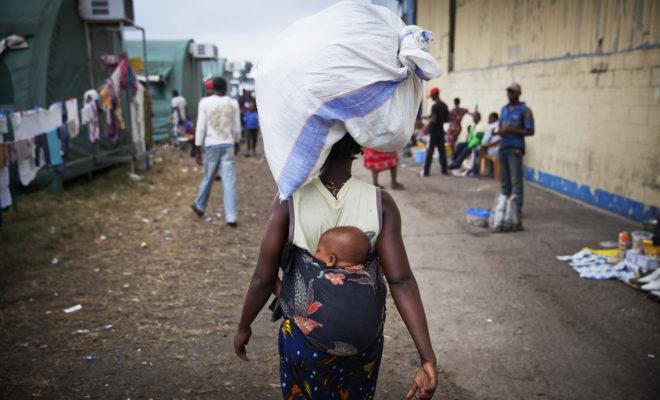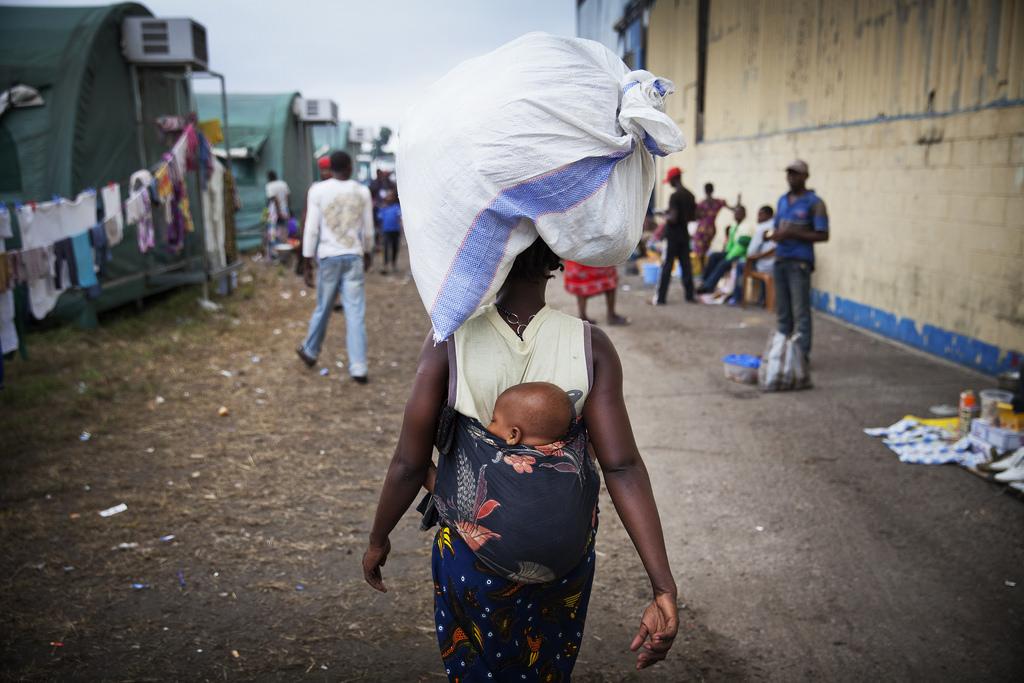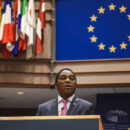It’s no longer possible to predict what’ll happen in the Congo

Kabila is flexing. Kasai is unravelling. Angola is smouldering.

There’s a great deal of uncertainty in Kinshasa. Credit: UN Photo/Sylvain Liechti.
The week before US President Donald Trump’s inauguration this January was an interesting time to be in the capital Kinshasa. The Democratic Republic of Congo‘s regime was in a peculiar mindset.
As they looked over to the US, officials recalled that Patrice Lumumba, DRC’s first freely-elected prime minister, was assassinated just a few days before the inauguration of John F. Kennedy in 1961. They also pointed out that President Laurent-Désiré Kabila was killed less than a week before George W. Bush first took office in 2001.
Some of those around the current president were convinced history would repeat − that there would be an attempt on Joseph Kabila’s life in the run-up to Trump’s inauguration. They claimed there was a conspiracy by the international community to atomise the Congo and neutralise Kabila like they had Saddam Hussein and Muammar Gaddafi.
What didn’t happen next
This assassination attempt never happened. And since that January, many more things have not happened.
Foremost among them is the implementation of the Saint Sylvester Agreement. This is the deal that was settled between the government and opposition on 31 December 2016. Made nearly two weeks after the official end of President Kabila’s second mandated term, the agreement ostensibly offers a roadmap out of the Congo’s political and constitutional crisis.
Facilitated by the Conference of Catholic Bishops, the agreement contains a commitment to respect the Constitution. It also includes several references to the fact that Kabila, who has been in office since 2001, will not stand for a third term. Instead, it says he will lead a transition government and hand over to a successor to be elected by the end of 2017.
On the one hand, the Saint Sylvester Agreement was an important achievement with consensus and concessions from all sides. There had been widespread protests through 2016, leading to dozens of deaths, and the deal allowed a period of fragile calm. It was also the result of a fully Congolese process, mediated by perhaps the last national institution to retain a degree of moral authority.
But on the other hand, it remains a vulnerable construct. The deal has several blind spots and gaps to be filled in through later negotiations. It was agreed between a divided ruling coalition and divided opposition. And it was made in a country with a long tradition of people signing deals without intending to respect them.
As a source within the regime said: “This agreement has the great merit of being unrealistic. It will be hard to implement. We will let the government led by the opposition govern and organise the elections. They will conclude soon enough that it is unfeasible to organise them before the end of the year, and when they pass their deadline, we will whistle at them as they whistled at us last December.”
Since the agreement, the government has consistently demonstrated its lack of will to organise elections. This was seen, amongst other occasions, as it exploited the predictable implosion of the opposition UDPS after the death of its leader Etienne Tshisekedi this February.
[What does opposition leader Tshisekedi’s death mean for DR Congo’s road to elections?]
But the opposition has hardly impressed either. The only activity to see progress is voter registration, and many believe this is because the regime is preparing for a constitutional referendum to propose removing the two-term presidential limit.
[Congo Come Back! Why we’re building a new political movement in DRC]
Local violence out of control
Away from Kinshasa, things are also increasingly uncertain as local conflicts have intensified in certain areas these past months.
The most dramatic developments have been in Kasai. Until recently, this region did not know the phenomenon of armed groups. But in August 2016, conflict was triggered by a succession dispute among customary authorities about 70 km from the city of Kananga.
The governor of Kasai Central tried to appoint someone against the will of the community. There were violent incidents in which the locally supported candidate was killed. And eventually a new armed movement called Kamwina Nsapu emerged.
Violence regularly flared up for the rest of 2016. It became permanent in January 2017. And it grew exponentially in February. The uprising, which started locally, spread across several provinces and was met with excessive violence.
Up to now, at least 42 mass graves have been discovered in the region. Meanwhile, two members of the UN Group of Experts − who were investigating human rights abuses and ties between the violence, national politics and the Congolese army − were found dead this March.
The case of Kasai shows how the Congolese state has lost its capacity to anticipate or even react to local conflicts. It exemplifies how areas get stuck between a formal administration that exists on paper but is not operational on the one hand, and customary authorities which often lack consensus and legitimacy and thus are vulnerable for manipulation on the other.
These tensions led to the massive violence in the Kasai and could happen in many other places in Congo where the same conditions apply.
[Don’t look away now: DR Congo is at greatest risk than for years]
International anxiety
At an international level, the Congo is also in flux. This can be seen in particular when it comes to Angola.
From the beginning of the Kabila family’s reign, its southern neighbour has been one of the regime’s most important partners. Both Laurent-Désiré and Joseph Kabila have been saved on various occasions by Angola.
The president considers this crucial support to be an expression of solidarity with his regime or even with him personally. But the reality is that Angola’s absolute priority is, and always has been, to avoid instability along its 2,500 km border with the DRC.
In the last months of 2016, Angola sent clear messages to Kabila to respect the Constitution and organise a transition within a reasonable time-frame. This position seems to be supported by the southern Africa regional bloc SADC as a whole. The region does not believe Kabila is able to provide stability and does not want the vast country to implode.
As the situation has worsened in 2017, Angola has not been amused by the lack of progress in the political process and even less by the 1.3 million displaced people in Kasai, which it borders. Many in Congo, including inside the regime, fear that Angola might take action to maximise pressure on Kabila.
Predicting the unpredictable
The result of all these dynamics − from the national-level impasse, to spreading local level conflicts, to increasingly anxious neighbours − is that nobody knows what to expect. It is no longer possible to predict what will happen in the Congo.
On the one hand, the regime radiates self-confidence and believes it can impose a referendum. Kabila seemed to confirm this in his interview with Der Spiegel, in which he commented: “To change the constitution is constitutional…You can change the constitution by referendum.”
But on the other hand, the president and his entourage know they are unpopular and that they can only win the referendum with fraud and/or intimidation. In a survey last year, 81.4% of respondents said they were against changing the constitution. Kabila’s government is also aware that its ability to control local conflicts is weak.
One of the key questions at the moment is of what effect the Western sanctions imposed on various senior officials in the last couple of weeks will have. Will they further undermine the cohesion of the regime? Or will they allow the government to close ranks and even win back a part of public opinion through a militant nationalist discourse?
As is becoming increasingly the case when it comes to the Congo, this too is nigh on impossible to predict.
Kris Berwouts’ new book Congo’s Violent Peace: Conflict and Struggle Since the Great African War is out in July 2017. It will be published as part of the African Arguments book series by ZED Books. It will be launched on 3 July. This article is drew on research Kris conducted for DfID’s DRC Evidence, Analysis and Coordination Programme (EACP), on behalf of Integrity Research and Consultancy.







Wouldn’t this mass killing amount to crime against humanity? or the rest of the world want more killing in order to intervene . Also one should know that the southern african blocks continue to support Kabila and le African union is useless because most of it members a long time dictators who either over stay therm terms like Kabila or revised the constitution to do so, in a way they have can not set a good example. That is my thought
Why are DRC Political Publics in a Gross Acute State of Disarray?
Political public events in DRC are approaching an ‘inflection moment’ in potential civic civil social disequilibrium negative, ensuring DRC Public Society is set back retrograde decades, as intense kinetic destructive forces may sharply breach any prescriptive positive social fabric binding DRC, a nation state in a limited sense of the term, as DRC is utterly lacking in robust independent institutions necessary in the advancement of Governance. In DRC, Institutions promoting Education are profoundly lacking in resources. Institutions promoting Medical Health Care are shattered. Institutions advancing Law inclusive of Justice have been hollowed out ensuring that rule of law in DRC remains a legal fiction. The Public Administrative Institution is beholden to the rent seekers which have been structured by 50 years of benign neglect by the DRC Governing Structure denying any enhancement of normative niceties in promotion of a functioning effective efficient bureaucracy.
My years in DRC as a Public Law Instructor has allowed me to observe and bear witness to the inter-niceties existing in DRC which are manifold as the DRC political public actors are for the greater part playing a dangerous game notwithstanding the profound acute frustration of the 80 million or so citizens who are suffering in despair.
During my time teaching, I have been privileged in being introduced to significant individuals of power and influence who themselves are Leaders in DRC Society.
My interactions with these DRC Elites has allowed me insight into the DRC civic civil social zeitgeist and my impressions are despondent, as these National Elites hold their citizens in contempt and regard the International Community with similar contemptuous disdain.
This ‘disdain’ is grounded within the DRC civic civil social matrix whereby visible strength in power is revered, feared and any weakness in the lacking of action in power is despised.
I believe DRC is on the cusp of emerging economic social greatness as an African National State administered and subject to norms grounded within rules ubiquitous for all Citizens, regardless of rank in status.
A DRC State reflecting strong the rule of law in process and in procedure I believe will create a political public cascading effect in Sub-Saharan Africa inordinate in the calming of ‘ad hoc’ extremism in rent seeking governance.
The Government of Canada is now reaffirming to the International Community at Large a re-commitment to engaging in International Peacekeeping Missions.
Therefore, in keeping with the values engrained within International Peacekeeping, I recommend the Western Democracies issue a Statement expressing strong support in the respecting of rule of law by President Kabila evinced in his adherence to the DRC Constitution, which alas this President has seen fit not to respect in leaving the Office as DRC President this past December.
A Public Statement by the International Community will illustrate clarion that democratic values without ‘fear or favour’ in rule of law matters as ‘practice’ and not merely as ‘fiction’.
The Western Democracies can make a profound difference in DRC social publics.
The Western Democracies ought to display in ‘publics’ that Principles of Governance subject to Rule of Law is not merely a talisman deployed for show when participating in International Forums.
Conviction to principles does matter, as other African Nations will be watching closely in how International Partners respect their own talk when engaging in post conflict development respecting other Nations States.
The Peoples of DRC will be watching too, as many innocent lives are in balance.
Why is DRC most challenged in elements social civic civil political publics culminating now in Joseph Kabila’s express intent in not respecting the DRC Constitution inclusive in rule of law which places time limits in executive term of office length?
My muse as to why current DRC civic civil public politics is roiled and astringent in utter lack of civic civil social cohesive capacity in performance and strengthening of public institutions can be traced to the moment of Congo Independence from Belgium in June 30, 1960.
I remain convinced that the circumstances surrounding the 1961 assassination of Prime Minister Patrice Lumumba witnessed the commencement and root of many of the present day problems afflicting DRC—–an African Nation State so rich rife in human capital potential and promise, yet most unactualized in social civic economic and public political specific ‘gravity’.
Something about Lumumba’s social civic public trajectory and the manner of his death offended global public opinion among both the elites and non elites, and has continued to attract and generate attention within the United Nations, and in Belgium and in the United States, and even in DRC itself. Many political public and social civic actors—–black Africans and white internationals created and instrumentalized Lumumba’s downfall.
A review of the Congo’s politics in 1960 both integrates and suggests for me the perspectives of at least four primary competing public civic actors.
1. the Congo’s inexperienced politicians who lacked absolute comprehension as to how to govern and why governance exists
2. a normative righteous presumptive yet most flawed United Nations exemplified by the then Secretary General Dag Hammarskjold who at times displayed an idealized form in absolute lack in prescriptive sound reasoned judgement when confronting crisis
3. an entrenched Belgian bureaucracy determined to hold on to and maintain past imperial prerogatives regardless of collateralized national Congo enmity directed to this soon to be vestigial colonialist ‘dictat’ in a land no longer Belgium sovereign
4. an arrogant and destructive United States which under CIA aegis elected to project ‘cold war’ leitmotiv into Congo social civics without regard to potential social civic strife.
This most arresting complex multi-dimensional tale of greed and power has intersecting narrative lines and an international array of participant actors. These diverse political public styles and variance in social civic conventions of propriety do require an explanation as well as a profound reflective consideration with the reward being a fuller complete and more profound understanding of a momentous event in African social civic public political topography.
The Congo in 1960 illustrates manifest the roots of empire, and also the exercise and deployment of power without mercy. The social public ruin of Lumumba displays in purest form the vicious character of society without sovereignty, and illustrates the deepest problems of political ethics. Today, DRC institutions of social civic governance are still entailed and encumbered within the antecedents of this past break down in social public civics. President Joseph Kabila’s refusal to respect and comply with the DRC Constitution is merely the resultant of Congo’s ongoing civic civil social disequilibrium which commenced on the day of Congo Independence, June 30,1960.